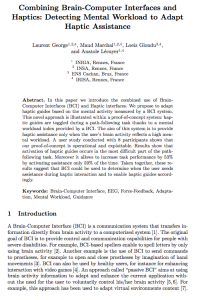
Combining Brain-Computer Interfaces and Haptics: Detecting Mental Workload to Adapt Haptic Assistance
Today I read a published paper titled “Combining Brain-Computer Interfaces and Haptics: Detecting Mental Workload to Adapt Haptic Assistance”
I think application of an assistance device in the medical field would be mind blowing (no pun intended). A device that could help a tired doctor diagnose a patient or a surgeon complete an operation.
Or in semi-autonomous vehicles when detecting driver fatigue. Hell, even if software development when you are really deep in the code.
The abstract is:
In this paper we introduce the combined use of Brain-Computer Interfaces (BCI) and Haptic interfaces. We propose to adapt haptic guides based on the mental activity measured by a BCI system. This novel approach is illustrated within a proof-of-concept system: haptic guides are toggled during a path-following task thanks to a mental workload index provided by a BCI. The aim of this system is to provide haptic assistance only when the user’s brain activity reflects a high mental workload. A user study conducted with 8 participants shows that our proof-of-concept is operational and exploitable. Results show that activation of haptic guides occurs in the most difficult part of the path-following task. Moreover it allows to increase task performance by 53% by activating assistance only 59% of the time. Taken together, these results suggest that BCI could be used to determine when the user needs assistance during haptic interaction and to enable haptic guides accordingly.